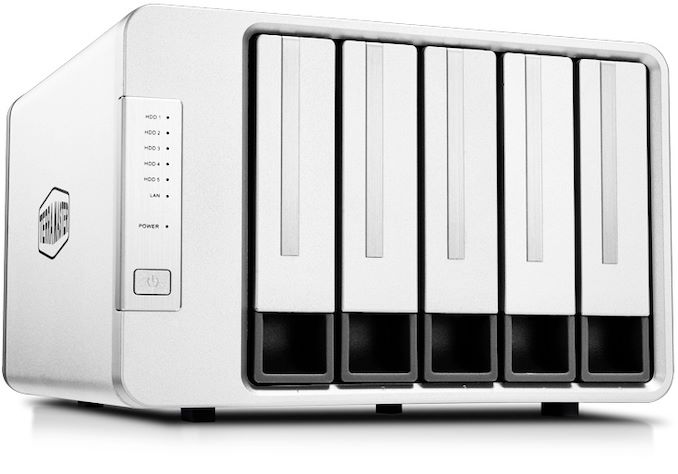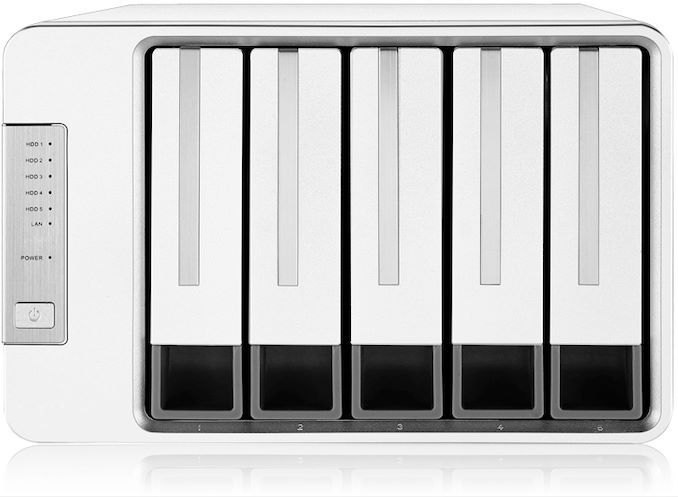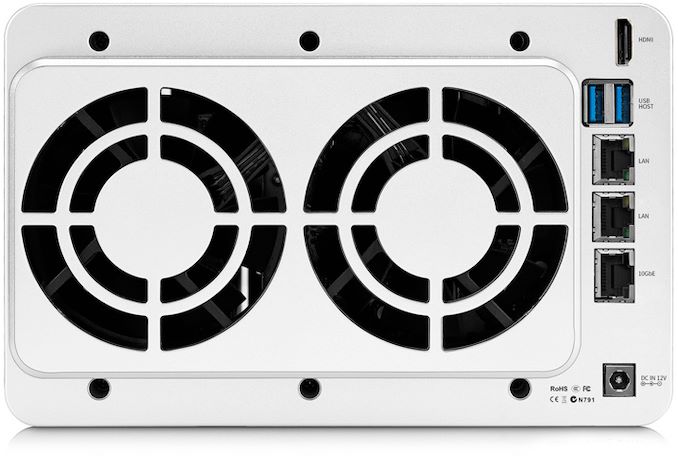CES 2020: TerraMaster Shows Off 5-Bay F5-422 NAS with 10 Gb Ethernet
by Anton Shilov on January 17, 2020 1:00 PM EST- Posted in
- NAS
- Storage
- Trade Shows
- TerraMaster
- CES 2020

TerraMaster unveiled a new five-bay NAS with a 10 GbE connectivity at this year's CES. The F5-422 is based upon Intel Apollo Lake SoC, and runs the company’s TOS 4.1 operating system on top of it, supporting up to 5 3.5-inch drives.
The TerraMaster F5-422 is powered by Intel’s Celeron J3455 quad-core SoC (1.5 GHz – 2.3 GHz) that is paired with 4 GB of memory (expandable to 12 GB). The unit can accommodate five 3.5-inch/2.5-inch hard drives or solid-state drives, which means with today's largest 16 TB HDDs, the NAS can accommodate a total of 80 TB in storage. And, as you'd expect for a modern NAS, the F5-422 supports various RAID modes, including RAID 1, RAID 5, RAID 6, and RAID 10.
Once released, the F5-422 NAS will be one of a handful of prosumer NASes on the market with support for high speed Ethernet, thanks to its one 10 GbE port. As well, the NAS supports two 1 GbE connectors, two USB 3.0 ports, and an HDMI display output. Though it should be noted that despite presence of an HDMI port, the NAS is not designed to work as a media player.
From performance point of view, the NAS is rated to read data at up to 670 MB/s speed as well as write data at up to 650 MB/s when all of its drives operate in RAID 5 mode. Meanwhile, TOS 4.1 OS supports SSD caching to accelerate I/O performance. The NAS can be used by large companies as it supports concurrent access for up to 500 users.
In addition to AES-NI and RAID modes, TerraMaster’s F5-422 with TOS 4.1 supports multiple security layers, including clustered Btrfs file system and snapshots as well as scheduled backups (including an option to back up to the cloud).
TerraMaster will begin selling the F5-422 shortly. Prices will vary with the configuration.
Related Reading:
- QNAP Unveils HS-453DX Silent NAS: Two HDDs, Quad-Core SoC, HDMI 2.0, 10 GbE
- QNAP Announces TS-332X Three-Bay NAS with 10 GbE
- QNAP Launches 16-Bay AMD Ryzen-Based TS-1677X NAS with 10 GbE
- Synology Introduces DiskStation DS1618+ with Intel Denverton
- Next-Gen NAS: An Interview with Alex Wang, CEO of Synology America
- QNAP Launches TS-963X NAS: x86 NAS With 9 Bays & 10 GbE/Multi-Gig Ethernet
Source: TerraMaster












33 Comments
View All Comments
Tyler_Durden_83 - Friday, January 17, 2020 - link
Why is every nas manufacturer using 4 years old parts?surt - Friday, January 17, 2020 - link
Cheap, and sufficient.imaheadcase - Friday, January 17, 2020 - link
Because you don't need high end parts for a NAS? Its for file serving. The same reason you don't need high end parts for do 4k video, its all down to what is just needed. In fact the specs are overkill in what normal usage is needed.Jorgp2 - Monday, January 20, 2020 - link
What's worse is that there's a quad core C3000 Series SoC in the same price range that has all the needed IO.It has 2x native 10G interfaces, and more than two SATA ports.
Valantar - Friday, January 17, 2020 - link
Looks pretty good. But let me guess, $800 or more without drives? In other words cheaper to go DIY with way more power? That seems to be how the NAS industry works.imaheadcase - Friday, January 17, 2020 - link
Why would you want way more power? Its a file server. You would hard pressed to use more of the CPU it has or ram with any task.imaheadcase - Friday, January 17, 2020 - link
On same note "cheaper" is not always better. I'm not sure with the OS this company uses, but synology makes everything so simple with its UI its kinda dumb proof for a business/average home user. Which is the exact point of a NAS. I built a home server before, this time when upgraded i just went with synology because less hassle than other one. It literally took less than 30min to setup..haven't needed to touch it since.The reason i built my own originally was the same reason most did, DYI was really only way to do streaming HD quality stuff because commercial NAS never took advantage of both worlds..they had file server OR media server if wanted to do that. So build own to do both.
Now, no need because every NAS you buy can do that pretty much.
close - Monday, January 20, 2020 - link
The biggest advantage a home/consumer NAS offers is the easy to use software. Then comes the actual package (the actual case, the size, the hot-plugging caddies, etc.). You can build a better or cheaper one and you can use software that could be way more powerful but far won't be nowhere as convenient as a small prebuilt NAS box with its own OS.jabber - Tuesday, January 21, 2020 - link
Some folks like to think in IT the 'hard way' is the only way. When IT is you job any unnecessary setting up and maintenance is to be avoided at all costs. 'Simple & Does the job' everytime.Valantar - Friday, January 17, 2020 - link
To transcode media, compress filed and run other relevant tasks? Not to mention that the CPU might well become a bottleneck if one puts an SSD in one of those bays for caching, especially with multiple users.